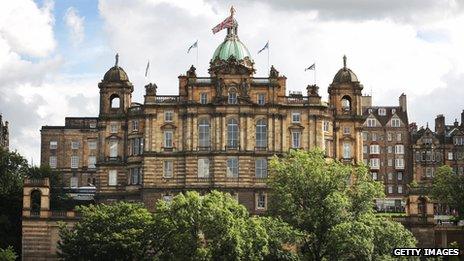Could RBS stay in an independent Scotland?
- Published
- comments

If Scotland became independent, would and could Royal Bank of Scotland and Bank of Scotland, owned by Lloyds, keep their homes there?
Scotland, and Edinburgh in particular, has a world class financial services industry, in banking, insurance and fund management.
The question posed by today's Scotland Analysis Paper from the Treasury is whether a Scotland that separated from the rest of the UK would be able to retain the bigger banks that are part of that industry.
This is something of concern to the two largest Scottish banks, Royal Bank of Scotland (RBS) and Bank of Scotland, and to Bank of Scotland's owner, Lloyds Banking Group. Its registered office is in Edinburgh, and can therefore be seen as Scottish in its entirety, although its top management is based in a London head office.
Directors of these banks are loathe to talk in public about their fears, because they don't want to be seen as influencing the highly charged debate on Scotland's future.
The nub of the problem was described to me by a senior Scottish banker: any big bank with a domicile or home in an independent Scotland might be seen as a much riskier borrower than an equivalent bank based in the UK, and it would therefore become much more expensive for that bank to borrow or raise vital finance.
"In my view," said the banker, "The moment that it looked as though Scotland were to win independence, funding costs would rise significantly, so RBS and Lloyds would have to move their homes to the City of London".
Banks too big?
So is this banker right? I should say his views are held by all the bankers I have spoken to about this over many months. But it doesn't mean they are correct, which is why it is worth unpicking their arguments.
There are basically two reasons why RBS and Lloyds might be viewed by those who lend to them as an altogether riskier proposition if Scotland separated from the rest of the UK.
First, they are very big relative to the size of the British economy, and they are enormous in proportion to the Scottish economy.
For example, the assets or loans and investments of British banks relative to the size of British GDP is around 500%.
Now many would say that shows that Britain's banking industry is way too big for the health and stability of the British economy.
It means, arguably, that if there was another systemic crisis for banks any time soon, the costs of saving those banks for a second time would be unaffordable for taxpayers - bankrupt banks would bankrupt the state.
Which is why officials such as Andy Haldane at the Bank of England are beginning to ask whether the big missing part of banking reform in recent years has been the absence of any attempt to curtail the size of banks.
If Haldane is right that size matters, in a bad way, then the implications for an independent Scotland would be troubling indeed - because in a nominal sense, Scottish banking assets are equivalent to 1,250% of Scottish GDP.
Just RBS on its own, according to its latest published balance sheet, has loans and investments of £1.3tn, equivalent to more than eight times Scottish GDP.
An unaffordable bailout
The Treasury's paper says that the bailout provided by the UK authorities to RBS in the crisis of 2008 would have been equivalent to 211% of Scotland's GDP - which suggests that an independent Scotland, all other things being equal, would not have been able to afford to bail out RBS.

Alex Salmond backed RBS's 2007 takeover of ABN Amro
It is probably worth pointing out at this juncture that Alex Salmond, Scotland's first minister and proponent of Scottish independence, supported RBS's ill-judged takeover in 2007 of the bulk of ABN Amro, the deal which massively increased both RBS's size and precariousness.
So, some would say, it is quite tricky for Mr Salmond to argue that all things would not have been equal in an autonomous Scotland.
Anyway, the point is that when investors and companies lend to a bank and when they invest in them, they look at what would happen to that bank if all went pear-shaped and said bank got into a serious financial mess.
They look at whether the government of the country which is home to that bank would bail the bank out in a crisis - thus reducing losses for the bank's creditors - and whether the relevant government could in practice afford to bail out the bank.
The point is that those who lend to RBS would note that the UK government was, in practice, only just able to afford to bail it out.
And they would have considerable doubts about whether the government of an independent Scotland would have deep enough pockets to do the same.
So if Scotland were to become independent, all other things being equal (the ghastly weasel words again), they might either refuse to lend to RBS or charge prohibitively expensive interest rates for doing so.
In those circumstances, RBS would have to pack its bags and move to London pronto.
Also, it is not just the strain on government finances of bailing out a bank that would be a concern to creditors of RBS and Lloyds.
There would be an even more pressing concern for them, which would be the banks' access to emergency liquidity and emergency loans when commercial sources of money dry up.
The big sterling question
The great triggers both of the 2007/8 global banking crisis and the 2012 eurozone banking crisis were that providers of credit to banks went on strike - and central banks had to step in with life-supporting loans.
Any bank with its headquarters in Scotland would need certainty about which central bank it could turn to for money when markets freeze - which central bank would be its lender of last resort.
Here is the thing: the Bank of England would only be prepared to act as the provider of loans to Scottish banks in a crisis if it was in charge of regulating and supervising these banks, as at present.
The Bank of England could not risk its own viability, and British taxpayers money, on supporting banks it could not boss around, in a supervisory sense.
Or to put it another way, the practicalities of whether RBS and Lloyds could continue to be Scottish banks are intricately bound up in a separate, hugely important, debate - which is whether Scotland would be part of a formal sterling zone, with the Bank of England as central bank for a separated Scotland.
And for Scotland to be a formal part of such a sterling zone, the Bank of England and HM Treasury would wish to impose constraints on the financial risks that Scotland's banks could take - to limit liabilities for British taxpayers.
Which could be yet another reason why Scottish banks might wish to move to London, where the Bank of England would judge their sustainability - and therefore the magnitude of risks they could take - on the basis of the British government's resources rather than the Scottish government's.
A couple of things follow, about the necessary conditions for an RBS or a Lloyds to remain headquartered in an independent Scotland (this is all on the assumption that an independent Scotland would view the high-skilled jobs associated with these banks having a Caledonian home as worth the risks of underwriting the banks' liabilities).
First, that investors - the notorious Mr Market - would impose limits on the scope of Scottish independence, if it wishes to remain the domicile of big banks.
This is uncontroversial. It is precisely what Mr Market is saying to the eurozone's governments if they wish their currency union to survive - namely that they have to pool their financial resources, and cede a degree of autonomous control over taxing and spending, to save the euro.
Second, that the more the British government is successful in reducing the innate riskiness of all British banks and their size, the easier it would be for Scotland to secede and keep its big banks.